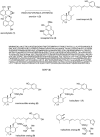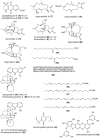Marine pharmacology in 2007-8: Marine compounds with antibacterial, anticoagulant, antifungal, anti-inflammatory, antimalarial, antiprotozoal, antituberculosis, and antiviral activities; affecting the immune and nervous system, and other miscellaneous mechanisms of action
- PMID: 20826228
- PMCID: PMC7110230
- DOI: 10.1016/j.cbpc.2010.08.008
Marine pharmacology in 2007-8: Marine compounds with antibacterial, anticoagulant, antifungal, anti-inflammatory, antimalarial, antiprotozoal, antituberculosis, and antiviral activities; affecting the immune and nervous system, and other miscellaneous mechanisms of action
Abstract
The peer-reviewed marine pharmacology literature in 2007-8 is covered in this review, which follows a similar format to the previous 1998-2006 reviews of this series. The preclinical pharmacology of structurally characterized marine compounds isolated from marine animals, algae, fungi and bacteria is discussed in a comprehensive manner. Antibacterial, anticoagulant, antifungal, antimalarial, antiprotozoal, antituberculosis and antiviral activities were reported for 74 marine natural products. Additionally, 59 marine compounds were reported to affect the cardiovascular, immune and nervous systems as well as to possess anti-inflammatory effects. Finally, 65 marine metabolites were shown to bind to a variety of receptors and miscellaneous molecular targets, and thus upon further completion of mechanism of action studies, will contribute to several pharmacological classes. Marine pharmacology research during 2007-8 remained a global enterprise, with researchers from 26 countries, and the United States, contributing to the preclinical pharmacology of 197 marine compounds which are part of the preclinical marine pharmaceuticals pipeline. Sustained preclinical research with marine natural products demonstrating novel pharmacological activities, will probably result in the expansion of the current marine pharmaceutical clinical pipeline, which currently consists of 13 marine natural products, analogs or derivatives targeting a limited number of disease categories.
Copyright © 2010. Published by Elsevier Inc.
Figures


















References
-
- Abad M.J., Bedoya L.M., Bermejo P. Natural marine anti-inflammatory products. Mini Rev. Med. Chem. 2008;8:740–754. - PubMed
-
- Abdel-Lateff A. Chaetominedione, a new tyrosine kinase inhibitor isolated from the algicolous marine fungus Chaetomium sp. Tetrahedron Lett. 2008;49:6398–6400.
-
- Adams B., Porzgen P., Pittman E., Yoshida W.Y., Westenburg H.E., Horgen F.D. Isolation and structure determination of malevamide E, a dolastatin 14 analogue, from the marine cyanobacterium Symploca laete-viridis. J. Nat. Prod. 2008;71:750–754. - PubMed
-
- Ahn G., Hwang I., Park E., Kim J., Jeon Y.J., Lee J., Park J.W., Jee Y. Immunomodulatory effects of an enzymatic extract from Ecklonia cava on murine splenocytes. Mar. Biotechnol. (NY) 2008;10:278–289. - PubMed
-
- Aiello A., Fattorusso E., Giordano A., Menna M., Müller W.E., Perovic-Ottstadt S., Schroder H.C. Damipipecolin and damituricin, novel bioactive bromopyrrole alkaloids from the Mediterranean sponge Axinella damicornis. Bioorg. Med. Chem. 2007;15:5877–5887. - PubMed
Publication types
MeSH terms
Substances
Grants and funding
LinkOut - more resources
Full Text Sources
Other Literature Sources

